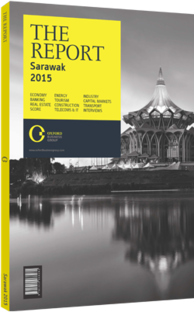OBG talks to Wilson Baya Dandot, CEO, Regional Corridor Development Agency (RECODA)

Interview: Wilson Baya Dandot
How is the Sarawak Corridor of Renewable Energy (SCORE) developing, and how is its employment potential being made clear to the public?
WILSON BAYA DANDOT: The broader development journey of Sarawak over the past 20 or 30 years has laid the foundation for the state’s economic growth, and the impact on GDP growth and rise in per capita income over the years has been evident. SCORE is a manifestation of this growth at its current stage, and its key importance lies within the new kinds of jobs that are being created and that will be created in the future through the implementation of the growth corridor, due to the range of different industries represented. Different and newer skills will arise out of the variety of activities taking place here, and each area of SCORE has its own unique features.
A real understanding of SCORE, its concept and our plan for it requires time. On our part, it is a continuous process of informing, indicating what needs to be done. Our leaders, ministers and politicians have played a large role in communicating to the public through discussions of SCORE over the past five or six years and will continue to do so. At the same time, we are now in a better position to talk about SCORE because tangible things are happening on the ground. With concrete examples of investment and the infrastructure projects being implemented, Sarawakians are attaining a deeper understanding of the benefits and potential of SCORE.
Students are looking at SCORE from an employment perspective and are undergoing training. However, in addition to the technical skills that will be required for the present and in the future, soft skills are needed as well. When activities in SCORE begin in earnest, lawyers, engineers, financiers and consultants will be in demand, and the state needs to ensure that it has enough service providers readily available for the area.
What direct benefits and challenges does the nodal model of development present?
DANDOT: SCORE is a very unique economic corridor distinct from others in Malaysia because of its nodal model of activity, which determines both the economic and geographic progress of the corridor. The development initially identified five growth nodes, not just Samalaju, where most of the initial heavy industry investment is taking place, but also Tanjung Manis, Mukah, Baram and Tunoh. That being said, it is certain that secondary growth nodes will emerge as these pilot projects generate the need for new activities, settlements and service centres. This is the natural process of economic development, as you cannot expect people to remain in one place but rather must expect new niche activities to develop in other areas.
These goals are currently being planned, and once implementation is under way, it will be possible to truly feel the pulse of development and will be exciting to see the natural direction that these segments and complementary industries eventually take.
Now that many of the trigger industries located in Samalaju are up and running, to what extent will there be a shift in focus to other nodes?
DANDOT: The reason that Samalaju and, to some extent, Tanjung Manis and Mukah have been developed before the other nodes is that the current major driver of SCORE is energy. Sarawak Energy, through its work in Bakun, Murum and its other power plants, is providing readily accessible power, which in turn has drawn energy-intensive investors. Many of the other growth nodes within SCORE, such as Baram and Tunoh, are located in the hinterland and are obviously dissimilar to Samalaju. For example, for industrialisation to occur there is a need for ports, which is not possible in inland areas. Thus, there are different kinds of economic activities that need to take place. I think we are ready to move in that direction as this aligns with the government’s rural transformation programme. The most critical aspect for the development of growth nodes is infrastructure, namely roads for connectivity and mobility. By facilitating the transport of produce in these areas, the foundation is set for industrial crop production.
How is the challenge of integrating indigenous populations that are already living within the rural growth nodes being addressed?
DANDOT: The integration of indigenous populations, especially within the rural growth nodes, is being taken seriously. The government is planning, not just through township developments but also through economic planning, to bring the local populace directly into economic activity to be part and parcel of the growth that is to take place. In the context of today’s globalised world, as much as we wish to ensure that the localised aspects of townships are preserved, we must anticipate the eventuality of changing demographics, both in terms of socioeconomic class and profession.
How do you assess the level of infrastructural development within SCORE at present, and what further goals are being targeted in the short term?
DANDOT: Positive progress has already been made with the Samalaju Industrial Port and Tanjung Manis Integrated Port, which are in place to immediately service the economic production that is occurring within their respective areas. For other infrastructural developments, it is hard to say where they will be until we discover the full range of economic services and products that these places can offer.
As previously mentioned, enhancing connectivity to rural nodes is a major focus. In Baram, for example, there is huge potential for eco tourism as Sarawak’s hinterland areas are endowed with beautiful natural resources. There will also be a new planned township located near the lake at Baram to give visitors a different and unique sense of living. However, we cannot simply build roads to these areas for the sake of building roads, there rather needs to be tangible economic activity taking place to justify such investment.
That being said, although ideally this development should be simultaneous, it is very beneficial to have infrastructure as a starting point to launch other activities once potential economic development is highlighted.
Certain areas have already been targeted for basic infrastructural development. For example, air connectivity is another area of focus that depends on need. In Mukah a new airport is currently being constructed due to the fact that the area has been designated a smart city and will have a training centre to develop a skilled workforce. Anywhere from 5000 to 10,000 students will soon be located there, in addition to the local population. Thus, it is already compelling to undertake major infrastructural projects in some cases, while in others the full range of needs in terms of size and capacity will be discovered upon further growth. More concrete progress will inevitably emerge and become linked with the existing network through economic activity and subsequent development.
With the Mukah node being designed as a “smart city”, what role do institutions in the remainder of Sarawak play in feeding SCORE?
DANDOT: While Mukah itself is being identified and developed as a smart city, there is no duplication taking place in terms of activities in Mukah and in Sarawak’s other, larger cities. What has happened in this area is that we have at least four institutions – namely Politeknik Mukah Sarawak, Universiti Teknologi Mara, Universiti Malaysia Sarawak and the Sarawak Skills Development Centre – that are committed to transforming Mukah. All four are either campuses or research centres in various stages of development at the moment. For all intents and purposes, Mukah is being devoted to workforce training and preparing human capital for SCORE. In other established cities, the educational focus is already well defined and has its own place within the state’s educational sphere. Skills development centres aside, studies have already been carried out for a Mukah Science Park, as well as the Matadeng Industrial Estate located 30 km away from Mukah, which will be focused on research and development, specifically bio-specific industry with food and palm applications. Thus, the various activities will certainly be complementary.
You have reached the limit of premium articles you can view for free.
Choose from the options below to purchase print or digital editions of our Reports. You can also purchase a website subscription giving you unlimited access to all of our Reports online for 12 months.
If you have already purchased this Report or have a website subscription, please login to continue.

